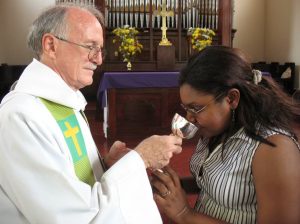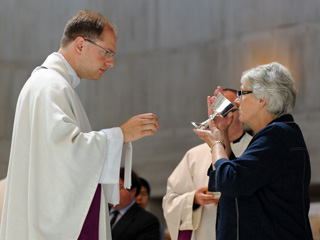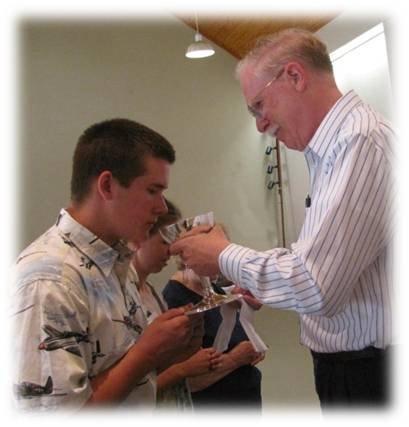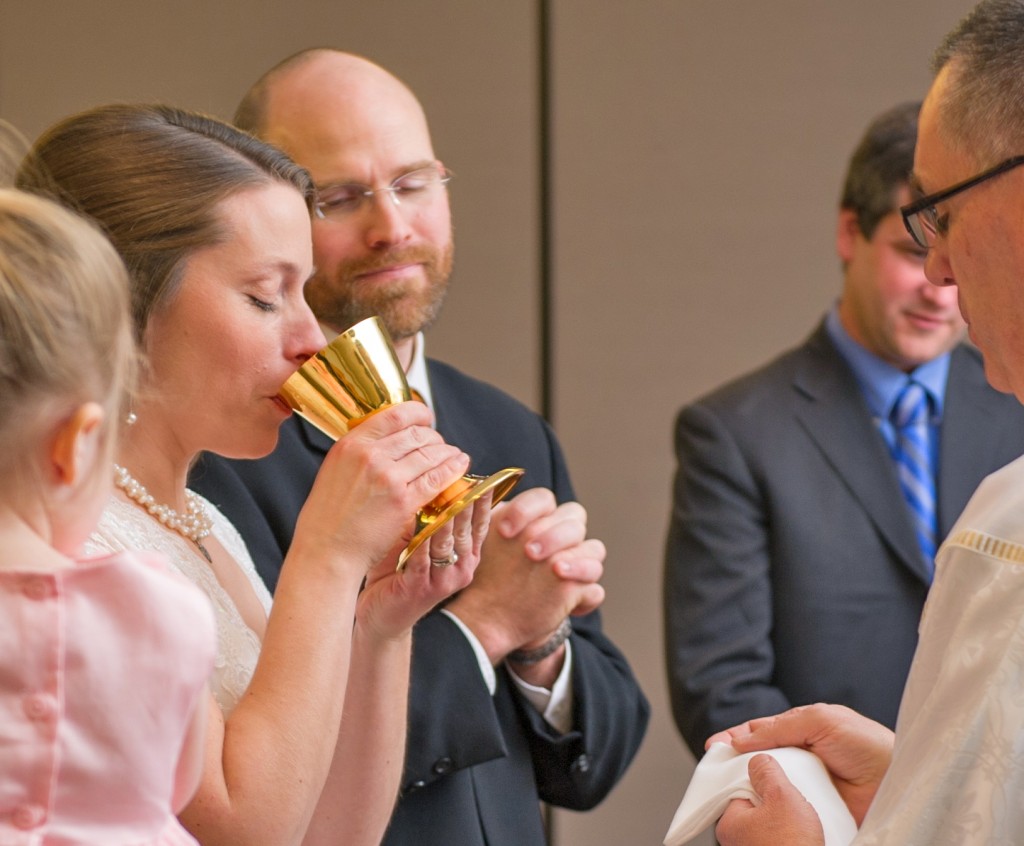OFFICE FOR THE LITURGICAL CELEBRATIONS
OF THE SUPREME PONTIFF
Doctrinal Formation and Communion Under Both Kinds
In the ordinary form of the Mass, the distribution of Holy Communion under both kinds is an option whose usage has become a daily occurrence in many countries but, by no means everywhere, even in Europe.
The instruction
"Redemptionis Sacramentum", promulgated in 2004, explains the context of this practice: "So that the fullness of the sign may be made more clearly evident to the faithful in the course of the Eucharistic banquet,
lay members of Christ’s faithful, too, are admitted to Communion under both kinds, in the cases set forth in the liturgical books, preceded and continually accompanied by proper catechesis regarding the dogmatic principles on this matter laid down by the Ecumenical Council of Trent" (100).
This laudable intention frequently meets the catechetical stumbling block mentioned. Undoubtedly, Holy Communion under both species illustrates Christ's intention that we eat his Body and drink his Blood. However, that desire for Holy Communion in both kinds has not necessarily been accompanied by fidelity to the norms of liturgical books and supporting formation to protect against Eucharistic abuses and doctrinal misunderstandings.
While many have grasped that the Eucharist is the "Source and Summit" of Christian life, the handing down of
the dogmatic principles of the Council of Trent has been seen as old-fashioned. The instruction has made clear that, intrinsic to the "fullness of the sign," is consistency with liturgical books and with the teachings of Trent.
"Redemptionis Sacramentum" displaces ambiguities of Eucharistic practice and "is directed toward such a conformity of our own understanding with that of Christ, as expressed in the words and the rites of the Liturgy" (5). Not infrequently, essential lack of Eucharistic awareness is revealed when, for want of formation, commissioned extraordinary ministers make reference to "giving out the wine." This very terminology suggests that, as part of their proper training, the dogmatic principle of Trent was not absorbed. Some might have heard about "substance" and "accidents" within the contexts of the religious education of yesteryear, but might have been encouraged to think that the Church had, somehow, moved on.
For modern generations, the Council of Trent may not have been mentioned in their doctrinal formation which emphasizes that "nothing is lost by the body being received by the people without the blood: because the priest both offers and receives the blood in the name of all, and the whole Christ is present under either species" (Summa Theologiae, III, q. 80, a. 12, ad 3
). So, under the species of bread there is also present, by concomitance, the precious blood.
The purpose, then, of receiving Holy Communion under both kinds, is not that the faithful receive more grace than when they receive it under one kind alone, but that the faithful are enabled to appreciate vividly the value of the sign. Sadly, this distinction has not always been made clear and some people, when not offered Holy Communion under both kinds, have expressed a sense of bewilderment, even thwarted entitlement, or a feeling that Holy Communion under one kind alone was, to some extent, deficient.
Bishops conferences and diocesan bishops, in particular, are the key to ensuring locally that Holy Communion is distributed with reverence and avoidance of misunderstanding.
"Redemptionis Sacramentum" makes clear that the slightest danger of the sacred species being profaned is to be avoided (101). It also expresses concern about the "detriment of so great a mystery" (106). While "profanation" and the "detriment of so great a mystery" suggest different levels of Eucharistic abuse, both levels are expressly mentioned so that they will be avoided.
Every care should be taken to avoid the ministering of the chalice where circumstances suggest ambiguity of reception or a setting where the safety of the contents of the chalice might not be assured.
"Redemptionis Sacramentum" states that where it is difficult to assess the quantity of wine needed for a particular celebration, owing to the large size of the congregation expected that the chalice is not to be ministered (102).
Alternative methods could be equally difficult to envisage such as the use of a spoon or a tube where these options are not the local custom. For Holy Communion by intinction, "the communicant must not be permitted to intinct the host himself in the chalice, nor to receive the intincted host in the hand" (104).
Forthcoming translations of the third edition of the Roman Missal mark, as the Bishops’ Conference of England and Wales wrote in their joint pastoral letter of May 2011, "a moment of special grace." It is to be hoped that the envisaged in-depth catechesis on the Mass will revisit the mentality and the manner in which Holy Communion is received.
It sounds restrictive to suggest that Holy Communion received fervently under one species is more fruitful than a tepid Communion received under both species when concrete objectives aimed at doctrinal formation, care and reverence in the liturgical celebration and organizational forethought could do so much to acknowledge and address the challenges that have arisen.
The psalmist declares the imperative of that in-depth catechesis: "The things we have heard and understood, the things our fathers have told us these we will not hide from their children but will tell to the next generation" (Psalm 78:4).
St. Ambrose discloses what people of faith gain from that knowledge: "For as often as we eat this Bread and drink this cup, we proclaim the death of the Lord. If we proclaim the Lord’s death, we proclaim the forgiveness of sins. If, as often as his Blood is poured out, it is poured for the forgiveness of sins, I should always receive it, so that it may always forgive my sins. Because I always sin, I should always have a remedy" (St Ambrose, De sacr. 4, 6, 28: PL 16, 464).






